Check answers here:
Modules 14 – 16: Routing Concepts and Configuration Exam Answers
Quiz-summary
0 of 64 questions completed
Questions:
- 1
- 2
- 3
- 4
- 5
- 6
- 7
- 8
- 9
- 10
- 11
- 12
- 13
- 14
- 15
- 16
- 17
- 18
- 19
- 20
- 21
- 22
- 23
- 24
- 25
- 26
- 27
- 28
- 29
- 30
- 31
- 32
- 33
- 34
- 35
- 36
- 37
- 38
- 39
- 40
- 41
- 42
- 43
- 44
- 45
- 46
- 47
- 48
- 49
- 50
- 51
- 52
- 53
- 54
- 55
- 56
- 57
- 58
- 59
- 60
- 61
- 62
- 63
- 64
Information
CCNA 2 v7 Modules 14 – 16: Routing Concepts and Configuration Test Online
You have already completed the quiz before. Hence you can not start it again.
Quiz is loading...
You must sign in or sign up to start the quiz.
You have to finish following quiz, to start this quiz:
Results
0 of 64 questions answered correctly
Your time:
Time has elapsed
You have reached 0 of 0 points, (0)
| Average score |
|
| Your score |
|
Categories
- Not categorized 0%
- 1
- 2
- 3
- 4
- 5
- 6
- 7
- 8
- 9
- 10
- 11
- 12
- 13
- 14
- 15
- 16
- 17
- 18
- 19
- 20
- 21
- 22
- 23
- 24
- 25
- 26
- 27
- 28
- 29
- 30
- 31
- 32
- 33
- 34
- 35
- 36
- 37
- 38
- 39
- 40
- 41
- 42
- 43
- 44
- 45
- 46
- 47
- 48
- 49
- 50
- 51
- 52
- 53
- 54
- 55
- 56
- 57
- 58
- 59
- 60
- 61
- 62
- 63
- 64
- Answered
- Review
-
Question 1 of 64
1. Question
1 pointsWhich feature on a Cisco router permits the forwarding of traffic for which there is no specific route?Correct
Incorrect
-
Question 2 of 64
2. Question
1 pointsWhich three advantages are provided by static routing? (Choose three.)Correct
Incorrect
-
Question 3 of 64
3. Question
1 pointsWhat are two functions of dynamic routing protocols? (Choose two.)Correct
Incorrect
-
Question 4 of 64
4. Question
1 pointsWhat is an advantage of using dynamic routing protocols instead of static routing?Correct
Incorrect
-
Question 5 of 64
5. Question
1 pointsWhat happens to a static route entry in a routing table when the outgoing interface associated with that route goes into the down state?Correct
Incorrect
Hint
When the interface associated with a static route goes down, the router will remove the route because it is no longer valid. -
Question 6 of 64
6. Question
1 pointsWhat is a characteristic of a static route that matches all packets?Correct
Incorrect
Hint
A default static route is a route that matches all packets. It identifies the gateway IP address to which the router sends all IP packets for which it does not have a learned or static route. A default static route is simply a static route with 0.0.0.0/0 as the destination IPv4 address. Configuring a default static route creates a gateway of last resort. -
Question 7 of 64
7. Question
1 pointsWhen would it be more beneficial to use a dynamic routing protocol instead of static routing?Correct
Incorrect
Hint
Dynamic routing protocols consume more router resources, are suitable for larger networks, and are more useful on networks that are growing and changing. -
Question 8 of 64
8. Question
1 pointsWhich route would be used to forward a packet with a source IP address of 192.168.10.1 and a destination IP address of 10.1.1.1?Correct
Incorrect
Hint
Even though OSPF has a higher administrative distance value (less trustworthy), the best match is the route in the routing table that has the most number of far left matching bits. -
Question 9 of 64
9. Question
1 pointsRefer to the exhibit. What is the administrative distance value of the route for router R1 to reach the destination IPv6 address of 2001:DB8:CAFE:4::A?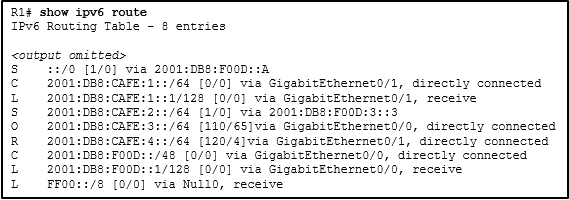 Correct
Correct
Incorrect
Hint
The RIP route with the source code R is used to forward data to the destination IPv6 address of 2001:DB8:CAFE:4::A. This route has an AD value of 120. -
Question 10 of 64
10. Question
1 pointsWhich value in a routing table represents trustworthiness and is used by the router to determine which route to install into the routing table when there are multiple routes toward the same destination?Correct
Incorrect
Hint
The administrative distance represents the trustworthiness of a particular route. The lower an administrative distance, the more trustworthy the learned route is. When a router learns multiple routes toward the same destination, the router uses the administrative distance value to determine which route to place into the routing table. A metric is used by a routing protocol to compare routes received from the routing protocol. An exit interface is the interface used to send a packet in the direction of the destination network. A routing protocol is used to exchange routing updates between two or more adjacent routers. -
Question 11 of 64
11. Question
1 pointsA network administrator configures the interface fa0/0 on the router R1 with the command ip address 172.16.1.254 255.255.255.0. However, when the administrator issues the command show ip route, the routing table does not show the directly connected network. What is the possible cause of the problem?Correct
Incorrect
Hint
A directly connected network will be added to the routing table when these three conditions are met: (1) the interface is configured with a valid IP address; (2) it is activated with no shutdown command; and (3) it receives a carrier signal from another device that is connected to the interface. An incorrect subnet mask for an IPv4 address will not prevent its appearance in the routing table, although the error may prevent successful communications. -
Question 12 of 64
12. Question
1 pointsRefer to the graphic. Which command would be used on router A to configure a static route to direct traffic from LAN A that is destined for LAN C?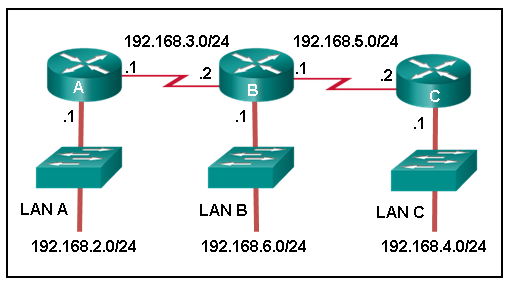 Correct
Correct
Incorrect
Hint
The destination network on LAN C is 192.168.4.0 and the next-hop address from the perspective of router A is 192.168.3.2. -
Question 13 of 64
13. Question
1 pointsOn which two routers would a default static route be configured? (Choose two.)Correct
Incorrect
Hint
A stub router or an edge router connected to an ISP has only one other router as a connection. A default static route works in those situations because all traffic will be sent to one destination. The destination router is the gateway of last resort. The default route is not configured on the gateway, but on the router sending traffic to the gateway. The router IOS does not matter. -
Question 14 of 64
14. Question
1 pointsRefer to the exhibit. This network has two connections to the ISP, one via router C and one via router B. The serial link between router A and router C supports EIGRP and is the primary link to the Internet. If the primary link fails, the administrator needs a floating static route that avoids recursive route lookups and any potential next-hop issues caused by the multiaccess nature of the Ethernet segment with router B. What should the administrator configure? Correct
Correct
Incorrect
Hint
A floating static route is a static route with an administrative distance higher than that of another route already in the routing table. If the route in the table disappears, the floating static route will be put into the routing table in its place. Internal EIGRP has an AD of 90, so a floating static route in this scenario would need to have an AD higher than 90. Also, when creating a static route to a multiaccess interface like a FastEthernet segment a fully specified route should be used, with both a next-hop IP address and an exit interface. This prevents the router from doing a recursive lookup, but still ensures the correct next-hop device on the multiaccess segment forwards the packet. -
Question 15 of 64
15. Question
1 pointsWhat is a characteristic of a floating static route?Correct
Incorrect
Hint
Floating static routes are static routes used to provide a backup path to a primary static or dynamic route, in the event of a link failure. They must be configured with a higher administrative distance than the original dynamic routing protocol has. A default static route is simply a static route with 0.0.0.0/0 as the destination IPv4 address. Configuring a default static route creates a gateway of last resort. -
Question 16 of 64
16. Question
1 pointsWhat network prefix and prefix-length combination is used to create a default static route that will match any IPv6 destination?Correct
Incorrect
Hint
A default static route configured for IPv6, is a network prefix of all zeros and a prefix mask of 0 which is expressed as ::/0. -
Question 17 of 64
17. Question
1 pointsConsider the following command:ip route 192.168.10.0 255.255.255.0 10.10.10.2 5
What does the 5 at the end of the command signify?Correct
Incorrect
Hint
The 5 at the end of the command signifies administrative distance. This value is added to floating static routes or routes that only appear in the routing table when the preferred route has gone down. The 5 at the end of the command signifies administrative distance configured for the static route. This value indicates that the floating static route will appear in the routing table when the preferred route (with an administrative distance less than 5) is down. -
Question 18 of 64
18. Question
1 pointsRefer to the exhibit. The routing table for R2 is as follows: Gateway of last resort is not set10.0.0.0/30 is subnetted, 2 subnets C 10.0.0.0 is directly connected, Serial0/0/0 C 10.0.0.4 is directly connected, Serial0/0/1 192.168.10.0/26 is subnetted, 3 subnets S 192.168.10.0 is directly connected, Serial0/0/0 C 192.168.10.64 is directly connected, FastEthernet0/0 S 192.168.10.128 [1/0] via 10.0.0.6
What will router R2 do with a packet destined for 192.168.10.129?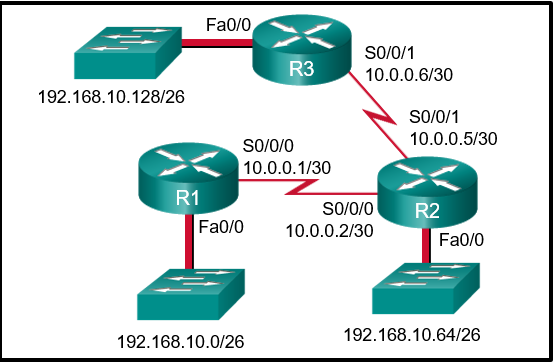 Correct
Correct
Incorrect
Hint
When a static route is configured with the next hop address (as in the case of the 192.168.10.128 network), the output of the show ip route command lists the route as “via” a particular IP address. The router has to look up that IP address to determine which interface to send the packet out. Because the IP address of 10.0.0.6 is part of network 10.0.0.4, the router sends the packet out interface Serial0/0/1. -
Question 19 of 64
19. Question
1 pointsAn administrator issues the ipv6 route 2001:db8:acad:1::/32 gigabitethernet0/0 2001:db8:acad:6::1 100 command on a router. What administrative distance is assigned to this route?Correct
Incorrect
Hint
The command ipv6 route 2001:db8:acad:1::/32 gigabitethernet0/0 2001:db8:acad:6::1 100 will configure a floating static route on a router. The 100 at the end of the command specifies the administrative distance of 100 to be applied to the route. -
Question 20 of 64
20. Question
1 pointsRefer to the exhibit. Which default static route command would allow R1 to potentially reach all unknown networks on the Internet?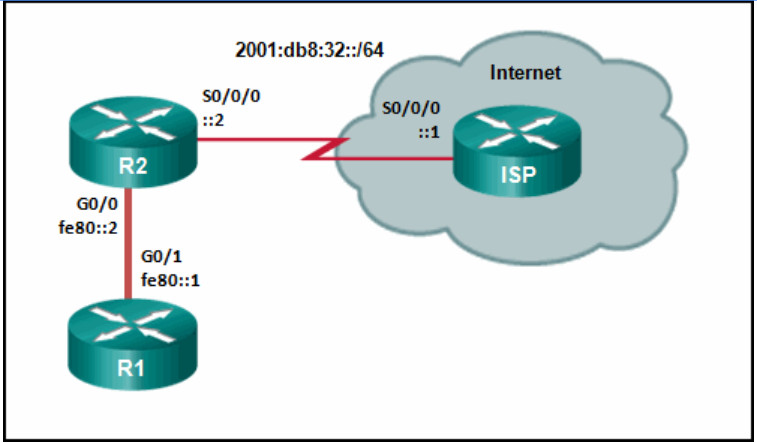 Correct
Correct
Incorrect
Hint
To route packets to unknown IPv6 networks a router will need an IPv6 default route. The static route ipv6 route ::/0 G0/1 fe80::2 will match all networks and send packets out the specified exit interface G0/1 toward R2. -
Question 21 of 64
21. Question
1 pointsRefer to the exhibit. The network engineer for the company that is shown wants to use the primary ISP connection for all external connectivity. The backup ISP connection is used only if the primary ISP connection fails. Which set of commands would accomplish this goal?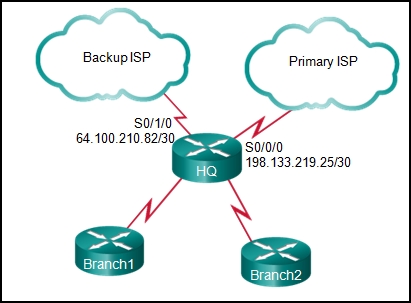 Correct
Correct
Incorrect
Hint
A static route that has no administrative distance added as part of the command has a default administrative distance of 1. The backup link should have a number higher than 1. The correct answer has an administrative distance of 10. The other quad zero route would load balance packets across both links and both links would appear in the routing table. The remaining answers are simply static routes (either a default route or a floating static default route). -
Question 22 of 64
22. Question
1 pointsRefer to the exhibit. Which set of commands will configure static routes that will allow the Park and the Alta routers to a) forward packets to each LAN and b) direct all other traffic to the Internet?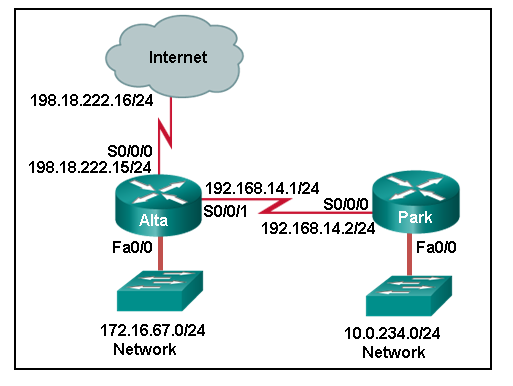 Correct
Correct
Incorrect
Hint
The LAN connected to the router Park is a stud network, therefore, a default route should be used to forward network traffic destined to non-local networks. The router Alta connects to both the internet and the Park router, it would require two static routes configured, one toward the internet and the other toward the LAN connected to the router Park. -
Question 23 of 64
23. Question
1 pointsRefer to the exhibit. The small company shown uses static routing. Users on the R2 LAN have reported a problem with connectivity. What is the issue?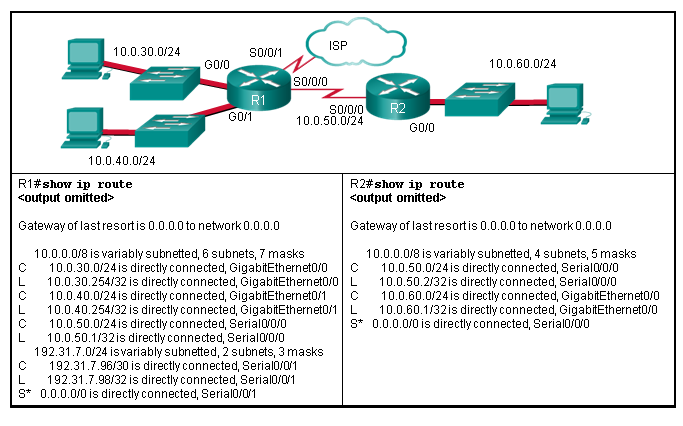 Correct
Correct
Incorrect
Hint
R1 has a default route to the Internet. R2 has a default route to R1. R1 is missing a static route for the 10.0.60.0 network. Any traffic that reached R1 and is destined for 10.0.60.0/24 will be routed to the ISP. -
Question 24 of 64
24. Question
1 pointsRefer to the exhibit. An administrator is attempting to install an IPv6 static route on router R1 to reach the network attached to router R2. After the static route command is entered, connectivity to the network is still failing. What error has been made in the static route configuration?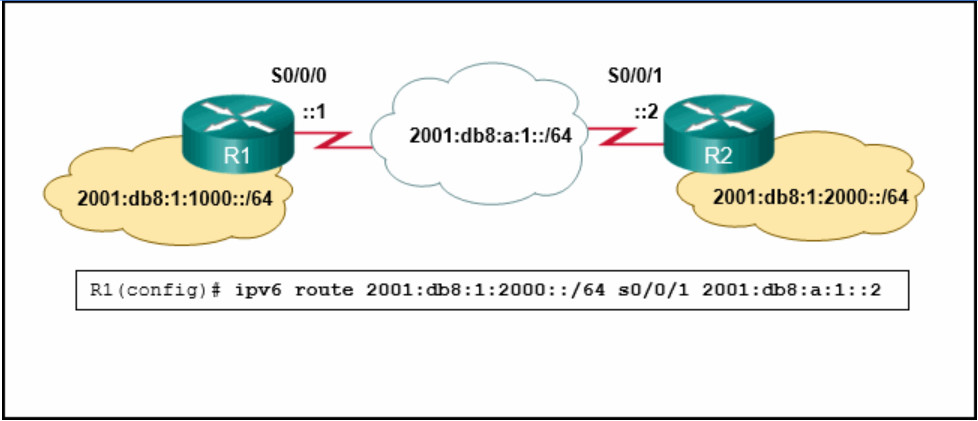 Correct
Correct
Incorrect
Hint
In this example the interface in the static route is incorrect. The interface should be the exit interface on R1, which is s0/0/0. -
Question 25 of 64
25. Question
1 pointsRefer to the exhibit. How was the host route 2001:DB8:CAFE:4::1/128 installed in the routing table?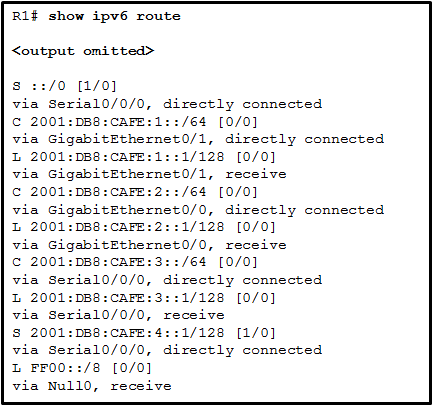 Correct
Correct
Incorrect
Hint
A host route is an IPv6 route with a 128-bit mask. A host route can be installed in a routing table automatically when an IP address is configured on a router interface or manually if a static route is created. -
Question 26 of 64
26. Question
1 pointsRefer to the exhibit. HostA is attempting to contact ServerB. Which two statements correctly describe the addressing that HostA will generate in the process? (Choose two.)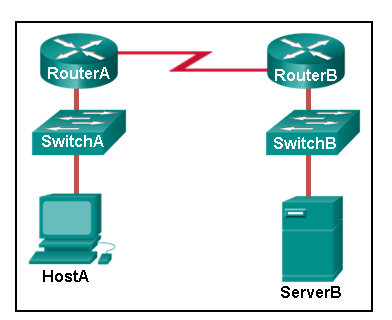 Correct
Correct
Incorrect
Hint
In order to send data to ServerB, HostA will generate a packet that contains the IP address of the destination device on the remote network and a frame that contains the MAC address of the default gateway device on the local network. -
Question 27 of 64
27. Question
1 pointsRefer to the exhibit. A ping from R1 to 10.1.1.2 is successful, but a ping from R1 to any address in the 192.168.2.0 network fails. What is the cause of this problem?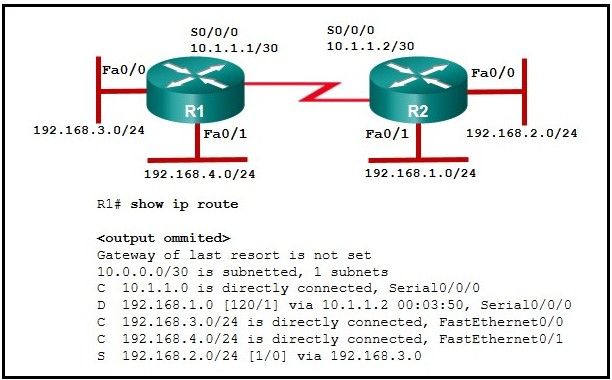 Correct
Correct
Incorrect
-
Question 28 of 64
28. Question
1 pointsRefer to the exhibit. An administrator is attempting to install a default static route on router R1 to reach the Site B network on router R2. After entering the static route command, the route is still not showing up in the routing table of router R1. What is preventing the route from installing in the routing table?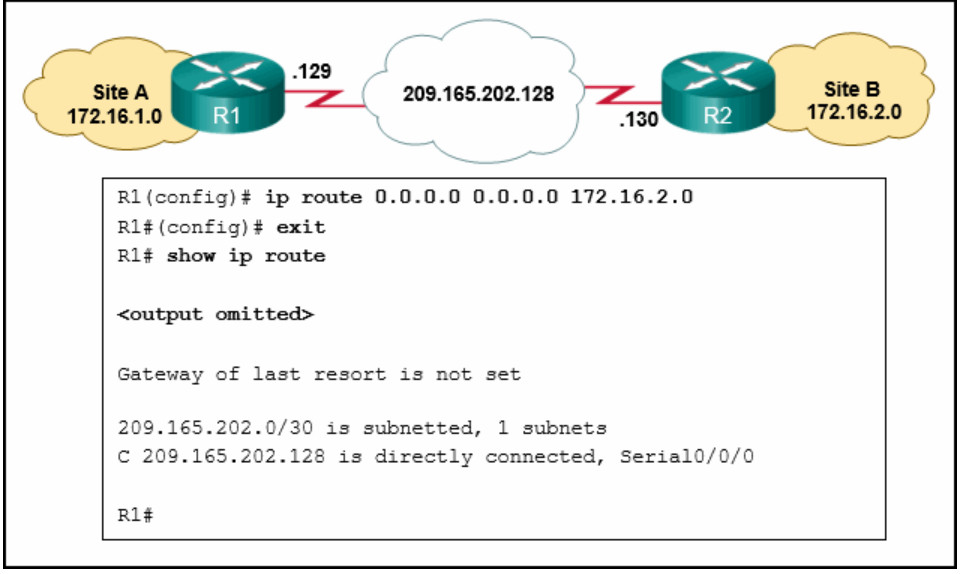 Correct
Correct
Incorrect
Hint
The next hop address is incorrect. From R1 the next hop address should be that of the serial interface of R2, 209.165.202.130. -
Question 29 of 64
29. Question
1 pointsRefer to the exhibit. The Branch Router has an OSPF neighbor relationship with the HQ router over the 198.51.0.4/30 network. The 198.51.0.8/30 network link should serve as a backup when the OSPF link goes down. The floating static route command ip route 0.0.0.0 0.0.0.0 S0/1/1 100 was issued on Branch and now traffic is using the backup link even when the OSPF link is up and functioning. Which change should be made to the static route command so that traffic will only use the OSPF link when it is up?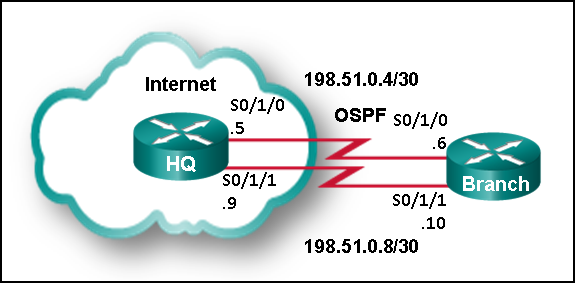 Correct
Correct
Incorrect
Hint
The problem with the current floating static route is that the administrative distance is set too low. The administrative distance will need to be higher than that of OSPF, which is 110, so that the router will only use the OSPF link when it is up. -
Question 30 of 64
30. Question
1 pointsWhat characteristic completes the following statement? When an IPv6 static route is configured, the next-hop address can be ……Correct
Incorrect
-
Question 31 of 64
31. Question
1 pointsGateway of last resort is not set.172.19.115.0/26 is variously subnetted, 7 subnets, 3 masks O 172.19.115.0/26 [110/10] via 172.19.39.1, 00:00:24, Serial0/0/0 O 172.19.115.64/26 [110/20] via 172.19.39.6, 00:00:56, Serial 0/0/1 O 172.19.115.128/26 [110/10] via 172.19.39.1, 00:00:24, Serial 0/0/0 C 172.19.115.192/27 is directly connected, GigabitEthernet0/0 L 172.19.115.193/27 is directly connected, GigabitEthernet0/0 C 172.19.115.224/27 is directly connected, GigabitEthernet0/1 L 172.19.115.225/27 is directly connected, GigabitEthernet0/1 172.19.39.0/24 is variably subnetted, 4 subnets, 2 masks C 172.19.39.0/30 is directly connected, Serial0/0/0 L 172.19.39.2/32 is directly connected, Serial0/0/0 C 172.19.39.4/30 is directly connected, Serial0/0/1 L 172.19.39.5/32 is directly connected, Serial0/0/1 S 172.19.40.0/26 [1/0] via 172.19.39.1, 00:00:24, Serial0/0/0 R1#
Refer to the exhibit. Which interface will be the exit interface to forward a data packet that has the destination IP address 172.19.115.206?Correct
Incorrect
-
Question 32 of 64
32. Question
1 pointsRefer to the exhibit. What routing solution will allow both PC A and PC B to access the Internet with the minimum amount of router CPU and network bandwidth utilization?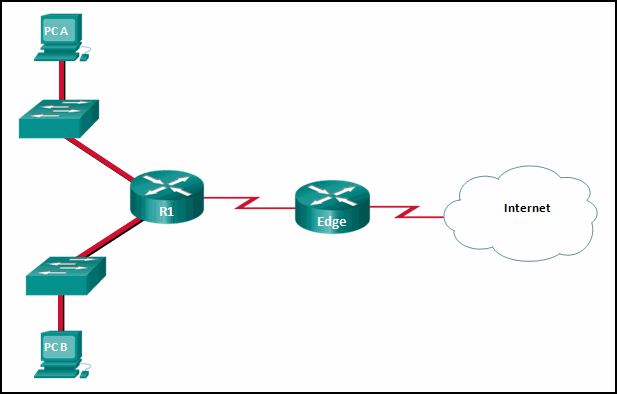 Correct
Correct
Incorrect
Hint
Two routes have to be created: a default route in R1 to reach Edge and a static route in Edge to reach R1 for the return traffic. This is a best solution once PC A and PC B belong to stub networks. Moreover, static routing consumes less bandwidth than dynamic routing. -
Question 33 of 64
33. Question
1 pointsRefer to the exhibit. What would happen after the IT administrator enters the new static route?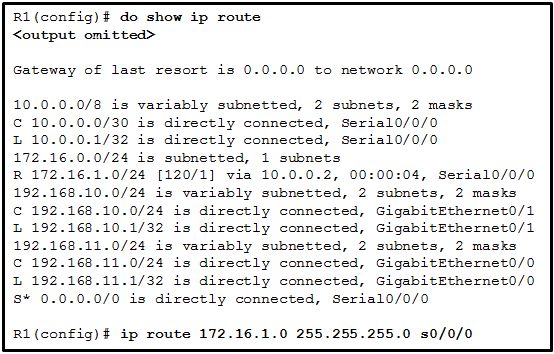 Correct
Correct
Incorrect
Hint
A route will be installed in a routing table if there is not another routing source with a lower administrative distance. If a route with a lower administrative distance to the same destination network as a current route is entered, the route with the lower administrative distance will replace the route with a higher administrative distance. -
Question 34 of 64
34. Question
1 pointsWhat two pieces of information are needed in a fully specified static route to eliminate recursive lookups? (Choose two.)Correct
Incorrect
Hint
A fully specified static route can be used to avoid recursive routing table lookups by the router. A fully specified static route contains both the IP address of the next-hop router and the ID of the exit interface. -
Question 35 of 64
35. Question
1 pointsRefer to the exhibit. Which command will properly configure an IPv6 static route on R2 that will allow traffic from PC2 to reach PC1 without any recursive lookups by router R2?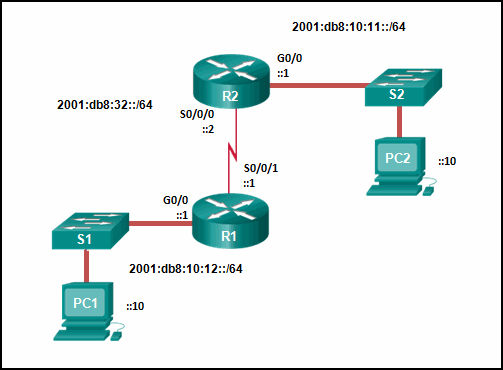 Correct
Correct
Incorrect
Hint
A nonrecursive route must have an exit interface specified from which the destination network can be reached. In this example 2001:db8:10:12::/64 is the destination network and R2 will use exit interface S0/0/0 to reach that network. Therefore, the static route would be ipv6 route 2001:db8:10:12::/64 S0/0/0. -
Question 36 of 64
36. Question
1 pointsRefer to the exhibit. Which static route would an IT technician enter to create a backup route to the 172.16.1.0 network that is only used if the primary RIP learned route fails?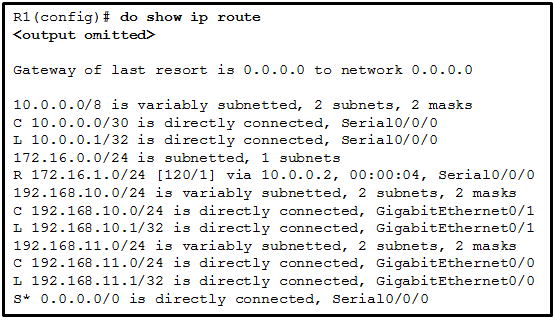 Correct
Correct
Incorrect
Hint
A backup static route is called a floating static route. A floating static route has an administrative distance greater than the administrative distance of another static route or dynamic route. -
Question 37 of 64
37. Question
1 pointsOpen the PT Activity. Perform the tasks in the activity instructions and then answer the question.A user reports that PC0 cannot visit the web server www.server.com. Troubleshoot the network configuration to identify the problem. What is the cause of the problem?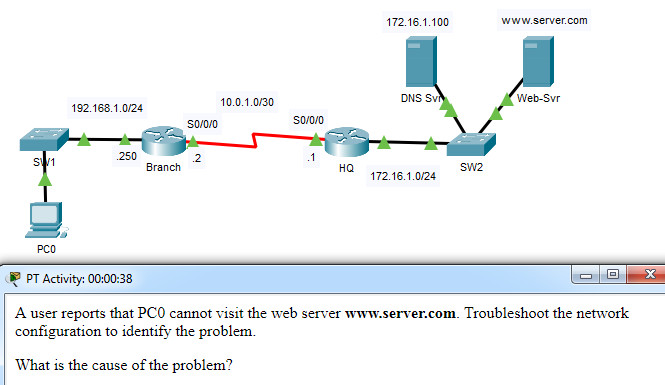
Modules 14 – 16: Routing Concepts and Configuration Exam
Correct
Incorrect
Hint
In order to allow communication to remote networks, proper routing, either static or dynamic, is necessary. Both routers must be configured with a routing method. -
Question 38 of 64
38. Question
1 pointsMatch the routing table entry to the corresponding function. (Not all options are used.)Sort elements
- identifies the trustworthiness of a route source
- identifies the value assigned to reach a remote network
- identifies how a route was learned
- identifies the address of the remote network
- identifies the exit interface used to route a packet to a destination
-
administrative distance
-
metric
-
route source
-
destination network
Correct
Incorrect
-
Question 39 of 64
39. Question
1 pointsRefer to the exhibit. PC A sends a request to Server B. What IPv4 address is used in the destination field in the packet as the packet leaves PC A? Correct
Correct
Incorrect
Hint
The destination IP address in packets does not change along the path between the source and destination. -
Question 40 of 64
40. Question
1 pointsWhat does R1 use as the MAC address of the destination when constructing the frame that will go from R1 to Server B?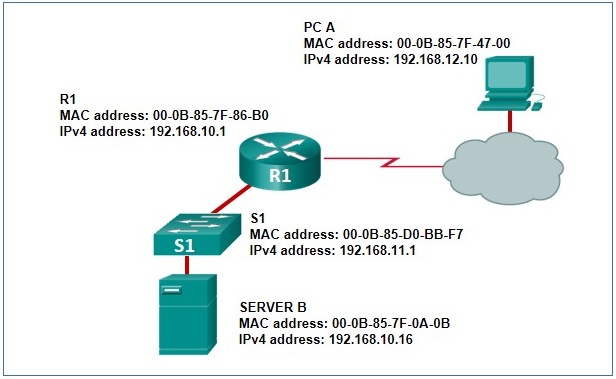 Correct
Correct
Incorrect
Hint
Communication inside a local network uses Address Resolution Protocol to obtain a MAC address from a known IPv4 address. A MAC address is needed to construct the frame in which the packet is encapsulated. -
Question 41 of 64
41. Question
1 pointsWhat route would have the lowest administrative distance?Correct
Incorrect
Hint
The most believable route or the route with the lowest administrative distance is one that is directly connected to a router. -
Question 42 of 64
42. Question
1 pointsA network administrator configures the interface fa0/0 on the router R1 with the command ip address 172.16.1.254 255.255.255.0. However, when the administrator issues the command show ip route, the routing table does not show the directly connected network. What is the possible cause of the problem?Correct
Incorrect
Hint
A directly connected network will be added to the routing table when these three conditions are met: (1) the interface is configured with a valid IP address; (2) it is activated with no shutdown command; and (3) it receives a carrier signal from another device that is connected to the interface. An incorrect subnet mask for an IPv4 address will not prevent its appearance in the routing table, although the error may prevent successful communications. -
Question 43 of 64
43. Question
1 pointsA router has used the OSPF protocol to learn a route to the 172.16.32.0/19 network. Which command will implement a backup floating static route to this network?Correct
Incorrect
Hint
OSPF has an administrative distance of 110, so the floating static route must have an administrative distance higher than 110. Because the target network is 172.16.32.0/19, that static route must use the network 172.16.32.0 and a netmask of 255.255.224.0. -
Question 44 of 64
44. Question
1 pointsConsider the following command:ip route 192.168.10.0 255.255.255.0 10.10.10.2 5
How would an administrator test this configuration?Correct
Incorrect
Hint
A floating static is a backup route that only appears in the routing table when the interface used with the primary route is down. To test a floating static route, the route must be in the routing table. Therefore, shutting down the interface used as a primary route would allow the floating static route to appear in the routing table. -
Question 45 of 64
45. Question
1 pointsRefer to the exhibit. Which type of IPv6 static route is configured in the exhibit? Correct
Correct
Incorrect
Hint
The route provided points to another address that must be looked up in the routing table. This makes the route a recursive static route. -
Question 46 of 64
46. Question
1 pointsWhat characteristic completes the following statement? When an IPv6 static route is configured, it is first necessary to configure ……Correct
Incorrect
-
Question 47 of 64
47. Question
1 pointsGateway of last resort is not set.172.18.109.0/26 is variously subnetted, 7 subnets, 3 masks O 172.18.109.0/26 [110/10] via 172.18.32.1, 00:00:24, Serial0/0/0 O 172.18.109.64/26 [110/20] via 172.18.32.6, 00:00:56, Serial 0/0/1 O 172.18.109.128/26 [110/10] via 172.18.32.1, 00:00:24, Serial 0/0/0 C 172.18.109.192/27 is directly connected, GigabitEthernet0/0 L 172.18.109.193/27 is directly connected, GigabitEthernet0/0 C 172.18.109.224/27 is directly connected, GigabitEthernet0/1 L 172.18.109.225/27 is directly connected, GigabitEthernet0/1 172.18.32.0/24 is variably subnetted, 4 subnets, 2 masks C 172.18.32.0/30 is directly connected, Serial0/0/0 L 172.18.32.2/32 is directly connected, Serial0/0/0 C 172.18.32.4/30 is directly connected, Serial0/0/1 L 172.18.32.5/32 is directly connected, Serial0/0/1 S 172.18.33.0/26 [1/0] via 172.18.32.1, 00:00:24, Serial0/0/0 R1#
Refer to the exhibit. Which interface will be the exit interface to forward a data packet that has the destination IP address 172.18.109.152?Correct
Incorrect
-
Question 48 of 64
48. Question
1 pointsRefer to the exhibit. What will the router do with a packet that has a destination IP address of 192.168.12.227?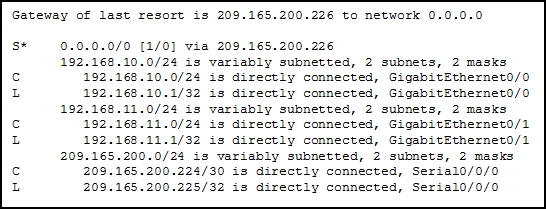 Correct
Correct
Incorrect
-
Question 49 of 64
49. Question
1 pointsConsider the following command:ip route 192.168.10.0 255.255.255.0 10.10.10.2 5
Which route would have to go down in order for this static route to appear in the routing table?Correct
Incorrect
-
Question 50 of 64
50. Question
1 pointsWhat are two advantages of static routing over dynamic routing? (Choose two.)Correct
Incorrect
-
Question 51 of 64
51. Question
1 pointsWhat characteristic completes the following statement? When an IPv6 static route is configured, it is possible that the same IPv6 link-local address is used for …Correct
Incorrect
-
Question 52 of 64
52. Question
1 pointsA network administrator configures the interface fa0/0 on the router R1 with the command ip address 172.16.1.254 255.255.255.0. However, when the administrator issues the command show ip route, the routing table does not show the directly connected network. What is the possible cause of the problem?Correct
Incorrect
-
Question 53 of 64
53. Question
1 pointsRefer to the exhibit. What command would be used to configure a static route on R1 so that traffic from both LANs can reach the 2001:db8:1:4::/64 remote network?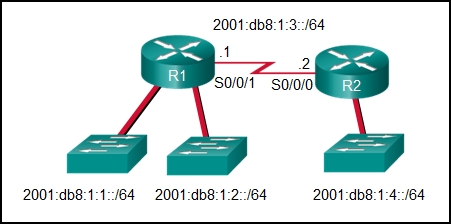 Correct
Correct
Incorrect
-
Question 54 of 64
54. Question
1 pointsRefer to the exhibit. What two commands will change the next-hop address for the 10.0.0.0/8 network from 172.16.40.2 to 192.168.1.2? (Choose two.)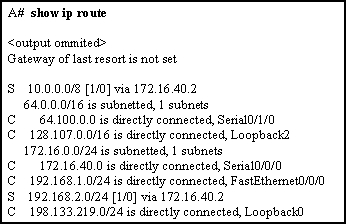 Correct
Correct
Incorrect
-
Question 55 of 64
55. Question
1 pointsRefer to the exhibit. Which interface will be the exit interface to forward a data packet that has the destination IP address 192.168.139.244?Gateway of last resort is not set. 192.168.139.0/26 is variously subnetted, 7 subnets, 3 masks O 192.168.139.0/26 [110/10] via 192.168.70.1, 00:00:24, Serial0/0/0 O 192.168.139.64/26 [110/20] via 192.168.70.6, 00:00:56, Serial 0/0/1 O 192.168.139.128/26 [110/10] via 192.168.70.1, 00:00:24, Serial 0/0/0 C 192.168.139.192/27 is directly connected, GigabitEthernet0/0 L 192.168.139.193/27 is directly connected, GigabitEthernet0/0 C 192.168.139.224/27 is directly connected, GigabitEthernet0/1 L 192.168.139.225/27 is directly connected, GigabitEthernet0/1 192.168.70.0/24 is variably subnetted, 4 subnets, 2 masks C 192.168.70.0/30 is directly connected, Serial0/0/0 L 192.168.70.2/32 is directly connected, Serial0/0/0 C 192.168.70.4/30 is directly connected, Serial0/0/1 L 192.168.70.5/32 is directly connected, Serial0/0/1 S 192.168.71.0/26 [1/0] via 192.168.70.1, 00:00:24, Serial0/0/0 R1#
Correct
Incorrect
-
Question 56 of 64
56. Question
1 pointsWhat characteristic completes the following statement? When an IPv6 static route is configured, a fully-specified configuration should be used with …Correct
Incorrect
-
Question 57 of 64
57. Question
1 pointsRefer to the exhibit. Which interface will be the exit interface to forward a data packet that has the destination IP address 192.168.71.52?Gateway of last resort is not set. 192.168.139.0/26 is variously subnetted, 7 subnets, 3 masks O 192.168.139.0/26 [110/10] via 192.168.70.1, 00:00:24, Serial0/0/0 O 192.168.139.64/26 [110/20] via 192.168.70.6, 00:00:56, Serial 0/0/1 O 192.168.139.128/26 [110/10] via 192.168.70.1, 00:00:24, Serial 0/0/0 C 192.168.139.192/27 is directly connected, GigabitEthernet0/0 L 192.168.139.193/27 is directly connected, GigabitEthernet0/0 C 192.168.139.224/27 is directly connected, GigabitEthernet0/1 L 192.168.139.225/27 is directly connected, GigabitEthernet0/1 192.168.70.0/24 is variably subnetted, 4 subnets, 2 masks C 192.168.70.0/30 is directly connected, Serial0/0/0 L 192.168.70.2/32 is directly connected, Serial0/0/0 C 192.168.70.4/30 is directly connected, Serial0/0/1 L 192.168.70.5/32 is directly connected, Serial0/0/1 S 192.168.71.0/26 [1/0] via 192.168.70.1, 00:00:24, Serial0/0/0 R1#
Correct
Incorrect
-
Question 58 of 64
58. Question
1 pointsWhat characteristic completes the following statement? When an IPv6 static route is configured, the installation of the route can be verified with ……Correct
Incorrect
-
Question 59 of 64
59. Question
1 pointsRefer to the exhibit. Which interface will be the exit interface to forward a data packet that has the destination IP address 10.55.99.78?Gateway of last resort is not set. 10.55.99.0/26 is variously subnetted, 7 subnets, 3 masks O 10.55.99.0/26 [110/10] via 10.55.18.1, 00:00:24, Serial0/0/0 O 10.55.99.64/26 [110/20] via 10.55.18.6, 00:00:56, Serial 0/0/1 O 10.55.99.128/26 [110/10] via 10.55.18.1, 00:00:24, Serial 0/0/0 C 10.55.99.192/27 is directly connected, GigabitEthernet0/0 L 10.55.99.193/27 is directly connected, GigabitEthernet0/0 C 10.55.99.224/27 is directly connected, GigabitEthernet0/1 L 10.55.99.225/27 is directly connected, GigabitEthernet0/1 10.55.18.0/24 is variably subnetted, 4 subnets, 2 masks C 10.55.18.0/30 is directly connected, Serial0/0/0 L 10.55.18.2/32 is directly connected, Serial0/0/0 C 10.55.18.4/30 is directly connected, Serial0/0/1 L 10.55.18.5/32 is directly connected, Serial0/0/1 S 10.55.19.0/26 [1/0] via 10.55.18.1, 00:00:24, Serial0/0/0 R1#
Correct
Incorrect
-
Question 60 of 64
60. Question
1 pointsA network administrator configures the interface fa0/0 on the router R1 with the command ip address 172.16.1.254 255.255.255.0. However, when the administrator issues the command show ip route, the routing table does not show the directly connected network. What is the possible cause of the problem?Correct
Incorrect
-
Question 61 of 64
61. Question
1 pointsRefer to the exhibit. Which interface will be the exit interface to forward a data packet that has the destination IP address 10.3.86.2?Gateway of last resort is not set. 10.3.86.0/26 is variously subnetted, 7 subnets, 3 masks O 10.3.86.0/26 [110/10] via 10.3.2.1, 00:00:24, Serial0/0/0 O 10.3.86.64/26 [110/20] via 10.3.2.6, 00:00:56, Serial 0/0/1 O 10.3.86.128/26 [110/10] via 10.3.2.1, 00:00:24, Serial 0/0/0 C 10.3.86.192/27 is directly connected, GigabitEthernet0/0 L 10.3.86.193/27 is directly connected, GigabitEthernet0/0 C 10.3.86.224/27 is directly connected, GigabitEthernet0/1 L 10.3.86.225/27 is directly connected, GigabitEthernet0/1 10.3.2.0/24 is variably subnetted, 4 subnets, 2 masks C 10.3.2.0/30 is directly connected, Serial0/0/0 L 10.3.2.2/32 is directly connected, Serial0/0/0 C 10.3.2.4/30 is directly connected, Serial0/0/1 L 10.3.2.5/32 is directly connected, Serial0/0/1 S 10.3.3.0/26 [1/0] via 10.3.2.1, 00:00:24, Serial0/0/0 R1#
Correct
Incorrect
-
Question 62 of 64
62. Question
1 pointsMatch the characteristic to the corresponding type of routing. (Not all options are used.)Correct
Incorrect
-
Question 63 of 64
63. Question
1 pointsRefer to the exhibit. Which interface will be the exit interface to forward a data packet that has the destination IP address 172.25.128.244?Gateway of last resort is not set. 172.25.128.0/26 is variously subnetted, 7 subnets, 3 masks O 172.25.128.0/26 [110/10] via 172.25.56.1, 00:00:24, Serial0/0/0 O 172.25.128.64/26 [110/20] via 172.25.56.6, 00:00:56, Serial 0/0/1 O 172.25.128.128/26 [110/10] via 172.25.56.1, 00:00:24, Serial 0/0/0 C 172.25.128.192/27 is directly connected, GigabitEthernet0/0 L 172.25.128.193/27 is directly connected, GigabitEthernet0/0 C 172.25.128.224/27 is directly connected, GigabitEthernet0/1 L 172.25.128.225/27 is directly connected, GigabitEthernet0/1 172.25.56.0/24 is variably subnetted, 4 subnets, 2 masks C 172.25.56.0/30 is directly connected, Serial0/0/0 L 172.25.56.2/32 is directly connected, Serial0/0/0 C 172.25.56.4/30 is directly connected, Serial0/0/1 L 172.25.56.5/32 is directly connected, Serial0/0/1 S 172.25.57.0/26 [1/0] via 172.25.56.1, 00:00:24, Serial0/0/0 R1#
Correct
Incorrect
-
Question 64 of 64
64. Question
1 pointsIpv6 route 2001:0DB8::/32 2001:0DB8:3000::1 Which static route is configured here?Correct
Incorrect

Very great practice for the CCNA 200-301. A lot of the exam is just examining routing tables